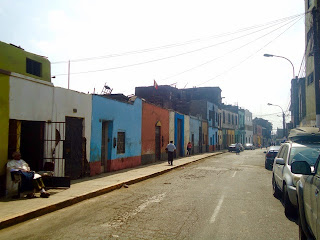The previous day in Lima we had bought some tickets to the bullfight from a ticket counter at a supermarket. Lima's bullfigting season runs from late October to early November, so the opportunitiy presented itself and this was something i had wanted to do for a long time. Admittedly, I think the idea of killing animals for sport or entertainment is morally indefensible, but i still wanted to see it, once. (I don't eat animals either but i still love the butchery sections of markets. I can't explain it. I just find it gruesome and facsinating.)
We walked out of the historic centre and across a highway and waterway into an area that is notably absent from the maps of Lima in all of my travel books. Across the way on a hill the slums of Lima are visible, with ramshackle houses seemingly piled on top of one another.
The area is distictly poor, with buildings crumbling, chaotic traffic, the strong smell of urine, and dusty streets lined with lively but shabby buildings. I loved it. The area was busy with everyone gathering before the fight. Spanish music played loudly, some recorded and some live; men gathered to drink beer and smoke, and women grilled meat on the streets, making impromptu eateries out of a cart and plastic chairs. Most people wore fancy, wide-brimmed white hats, which was about the only spiffy thing in site. (Being the only obvious foreigners in site, i didn't feel right taking pictures of the people, but i took this picture of a side street.)
We entered the bull ring: the Plaza Del Acho. It is the oldest bullring in the Americas, dating from 1766, and the second oldest in the world. The place was crammed full of spectators enjoying the pre fight ambiance. Grilled meats, live bands, wine, beer & pico vendors - even a cigar vendor! It was very exciting.
The events opened with a traditional Peruvian dance done to a live brass band which played on and off throughout the fight.
Then the crowd cheered as the matadors entered the ring.
There were six bulls that afternoon. Each fight (it hardly seems like the right word but i haven't a better one) follows the same formula. A bull is released. A half a dozen lesser matadors with fushia and yellow capes taunt the bull around the ring; getting it to run through their capes and around them. When the bull gets too close, they run and jump behind protective wooden barricades.
Then to trumpets the picadores enter the ring on horseback. They stab the bull with long spears between its shoulders. This causes the bull to bleed and get understandably pissed off. The bull then charges into the horse, often lifting it up and sometimes toppling thr rider. This was exciting. The horses wear armour to prevent them from being disembowled.
Then the matador appears, at first without his red cape. He begins by taunting the bull and stabbing it with six colourful, barbed instruments, which go into and hang down from the bull's shoulders.
By now the bull is bloody, angry, and tired. The matador then arms himself with a sword and red cape and begins the dance wherein the bull charges, the matador waves his through the cape, the crowd shouts "olé", and the matador struts cockily while the bull composes himself. This continues for a while during which time, a few times, the matadors are flipped, knocked down and nearly trampled, or in one case, gored in the leg. The always kept fighting, however (the matadors are pretty impressive. They must get laid constantly.) This was all kind of beautiful and very exciting when something went wrong. Make no mistake, i was rooting for the bull.
Then the matador stabs the bull with his sword, through the shoulders, into the chest, hilt deep. The bull bleeds from his wound and blood pours from his mouth. The bull staggers while the sub-matadors taunt the bull wuth their capes until it falls down (this is the worst part, in my opinion), at which point someone slits the bull's throat. The body is dragged from the ring by horses to the sound of cheers. The matador struts around while people throw roses and hats.
It's pretty cruel and awful, but also very interesting. I am defintely glad i went, though i don't know if i would again. I loved the cultural experience, and the pagentry, the music, and costumes - i also loved that you could smoke cigars, which i did throughout the event. The torture and killing gives me pause.
Reflecting on all we had seen, we left and went back to Miraflores for a vegatarian dinner and sleep. A very full day indeed.
d











1 comment:
Bullfights are cruel and I do feel bad for the bull. However if it wasn't for bull fights we would be over run with angry rampaging bulls.
Also I can't watch a bullfight without thinking of that Bugs Bunny cartoon where the bull boots the matador out of the arena and the crowd showers him with roses and applause...until Bugs Bunny shows up (he should have taken that left turn at Albuquerque).
Did you know bullfighters leading cause of death used to be pneumonia (in Spain anyway) the would work up a tremendous sweat in their ornate outfits under the blazing sun, but then in the late afternoon they would be in shade and the temperature could drop by as much as twenty degrees and as a result of being damp and cold they would get very sick.
Also speaking of Matador's getting laid, have you read Sun Also Rises? There's a passage where Lady Brett Ashley is drooling over the matador (yes she sleeps with him).
Post a Comment